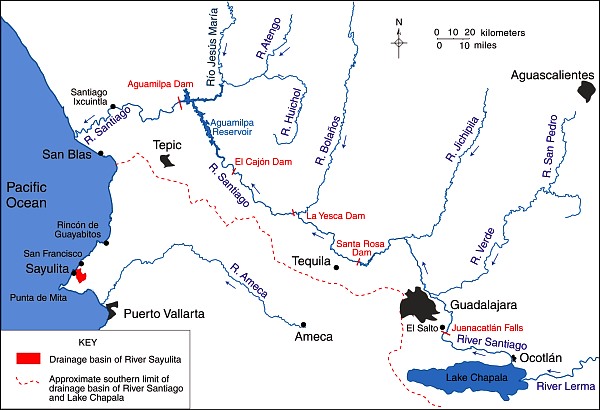Kudos to the Earth Island Institute for responding to the many criticisms we and others made of a blog article (“Water Pollution Plagues Mexico’s Scenic Pacific Coast”) by pulling it from their website. The following post has been edited to reflect that fact.
Water quality is a serious concern in many parts of Mexico and Geo-Mexico regularly includes short articles about the main issues as well as case studies related to water pollution (see “Related posts” below).
Ron Granich, a regular Geo-Mexico reader who lives in Pátzcuaro (Michoacán) and recognizes our keen interest in Mexico’s water quality kindly drew our attention to a recent article published on the website of the Earth Island Journal. Sadly, the blog article left much to be desired. The article was subtitled, “Tourists largely unaware that industrial pollution from rivers upstream is making them sick”, and attempted to argue that the pollution of Mexico’s Santiago River is a direct cause of the poor water quality of beach towns such as Sayulita.
The slight problem with this thesis is that the Santiago River flows nowhere near Sayulita and has no connection to the miniscule Sayulita River, far to its south (see map). There is no question that the Santiago is polluted. It collects serious pollutants from the major industrial area of El Salto (a short distance southeast of Guadalajara) and from Guadalajara, and from many smaller settlements along the way. More contaminants are added near its mouth, where the swampy delta has been transformed into productive fields, including tobacco plantations.
Pollution of the River Santiago is particularly evident at the Juanacatlán Falls near El Salto:
- Greenpeace demands action to clean up Mexico’s surface waters
- The “Niagara of Mexico”, the Juanacatlán Falls near Guadalajara
After the Juanacatlán Falls, the Santiago flows in a deep, steep-sided canyon for most of its course (which explains why no fewer than three major dams for hydro-electric power have been built along this stretch, including the one at La Yesca) before meandering across its delta to flow into the Pacific Ocean a short distance north of San Blas.
The Santiago River has no conceivable influence on the pollution levels in the rivers near Sayulita and San Francisco or indeed on beaches in their vicinity. This is not to say that those beaches are clean. The beaches of the Nayarit Riviera may indeed have high levels of Enterococcus spp, as we reported recently when looking at the murky world of water statistics in Mexico.
Note on clean water standards in Mexico and the USA:
It is sometimes argued that Mexico and the USA have different standards for what represents “clean water”. For marine (beach) environments, the U.S. limit is 35 Enterococci per 100 ml. of water, and is based on calculating a geometric mean of counts performed over a five week period. This method greatly reduces the impact of peak Enterococci counts. However, the Mexican limit of 100 Enterococci/100 ml. is based on a single sample maximum value. As explained in this US EPA technical document, Water Quality Standards for Coastal Recreation Waters: Using Single Sample Maximum Values in State Water Quality Standards, the two limits are approximately equivalent in terms of water quality. In other words, a geometric mean of 35 Enterococci/100 ml. means that the water is about as clean as a single maximum value of 100 Enterococci/100 ml.
Water quality IS a major concern in much of Mexico, and we applaud the Earth Island Institute for seeking to draw attention to the issues involved, and for their recent action in removing the original article, which helps to ensure that discussions of these issues are based on facts and not on misconceptions.
As always, we welcome discussion about this (and all our posts) via the comments feature. If the comments feature is not visible, simply click the title of the relevant post, and scroll down.
Related posts:
- Where in Mexico do people still lack access to potable water?
- Which cities have the best and worst water systems in Mexico?
- Mexico’s freshwater aquifers: undervalued and overexploited
- The availability of water in Mexico
- Mexico’s major cities confront serious water supply issues
- Two examples of Mexico-USA trans-border water pollution
- Swim at your peril through the murky data for Mexico’s beaches
3 Responses to “Major factual inaccuracies in “Water Pollution Plagues Mexico’s Scenic Pacific Coast” result in its removal from Earth Island Institute website”
Sorry, the comment form is closed at this time.

I hope you send this to the author, it would be interesting to see a response from Kelly to this.
This site is very interesting and informative, thanks very much.
Yes, we sent a draft of this to the author and the text as published here to the Earth Island editor for their consideration.
Thanks for the kind words, TB
You will be pleased to hear that the Earth Island Institute (EII) has removed the article we criticized from its website. We applaud the EII for its reaction and have amended our original post to reflect the fact that the original article has been removed.